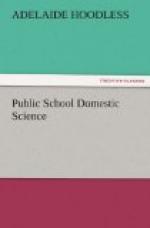MOLASSES AND TREACLE.
Molasses and treacle are formed in the process of crystallizing and refining sugar. Treacle is the waste drained from moulds used in refining sugar, and usually contains more or less dirt.
GLUCOSE.
Glucose, or grape sugar, is commonly manufactured from starch. It is found in almost all the sweeter varieties of fruit. It is not so desirable for general use as cane sugar.
HONEY.
Honey is a form of sugar gathered by bees from the nectar of flowering plants, and stored by them in cells. Honey contains water 16.13, fruit sugar 78.74, cane sugar 2.69, nitrogenous matter 1.29, mineral matter 0.12 per cent. (Konig.)
Grains.
While the grains contain less proteid than the legumes, they are more valuable on account of the variety of the nutrients contained in them, and are more easily adapted to the demands of the appetite. They, however, require long, slow cooking in order to soften the fibre and render the starch more soluble. Among the most important we may place:
WHEAT.
A wheat kernel may be subdivided into three layers. The first or outer one contains the bran; second, the gluten, fats and salts; third, the starch. Some of the mineral matter for which wheat is so valuable is contained in the bran, hence the value of at least a portion of that part of the wheat being included in bread flour—not by the addition of coarse bran (which is indigestible) to the ordinary flour, but by the refining process employed in producing whole wheat flour. While wheat is used in other forms, its principal use as food is in the form of flour.
The following table, giving the composition of bread from wheat and maize, will be of interest (Stone):—
COMPOSITION OF BREAD FROM WHEAT AND MAIZE.
-------------------------+-----------------------------
--------------- | In Air-Dry Material. +------+-----+-----+-------+--------+-------- | | | | | |Nitrogen |Water.| Ash.| Fat.| Fibre.|Protein.| free | | | | | |extract. -------------------------+------+-----+-----+-------+-------
-+-------- |P.ct. |P.ct.|P.ct.| P.ct. | P.ct. | P.ct. Bread from whole winter | | | | | | wheat | 3.07 | 2.33| 1.22| 2.86 | 15.70 | 74.82 Bread from whole spring | | | | | | wheat | 7.46 | 1.69| 1.24| 2.80 | 15.26 | 71.55




